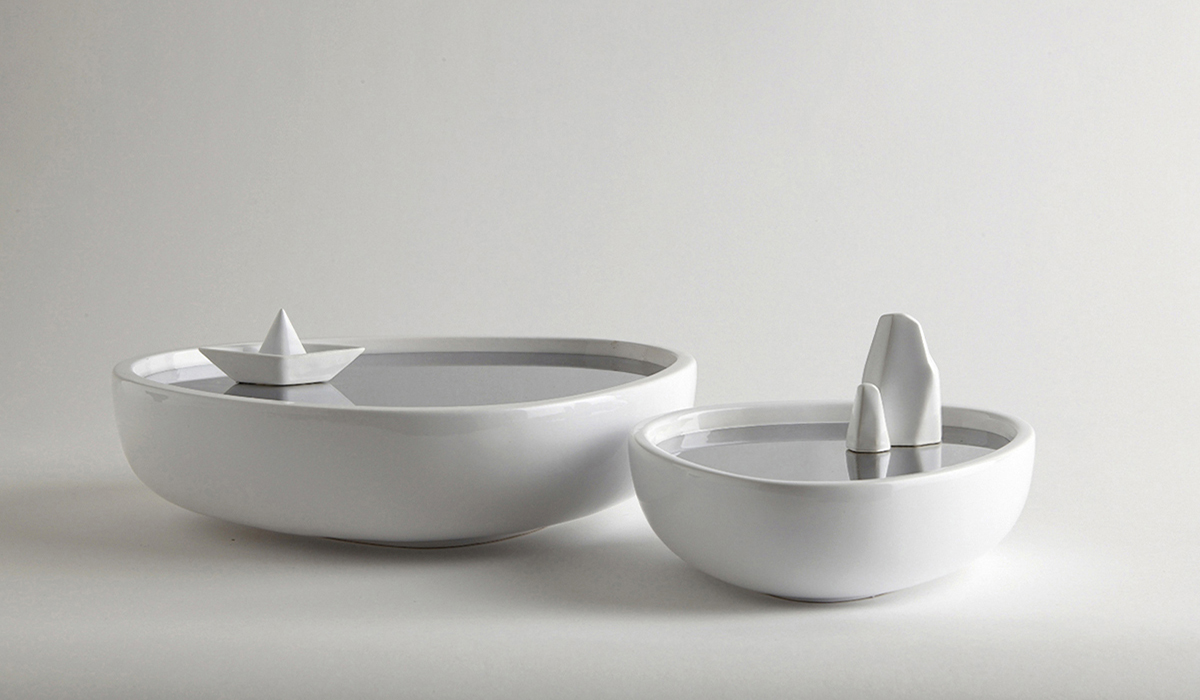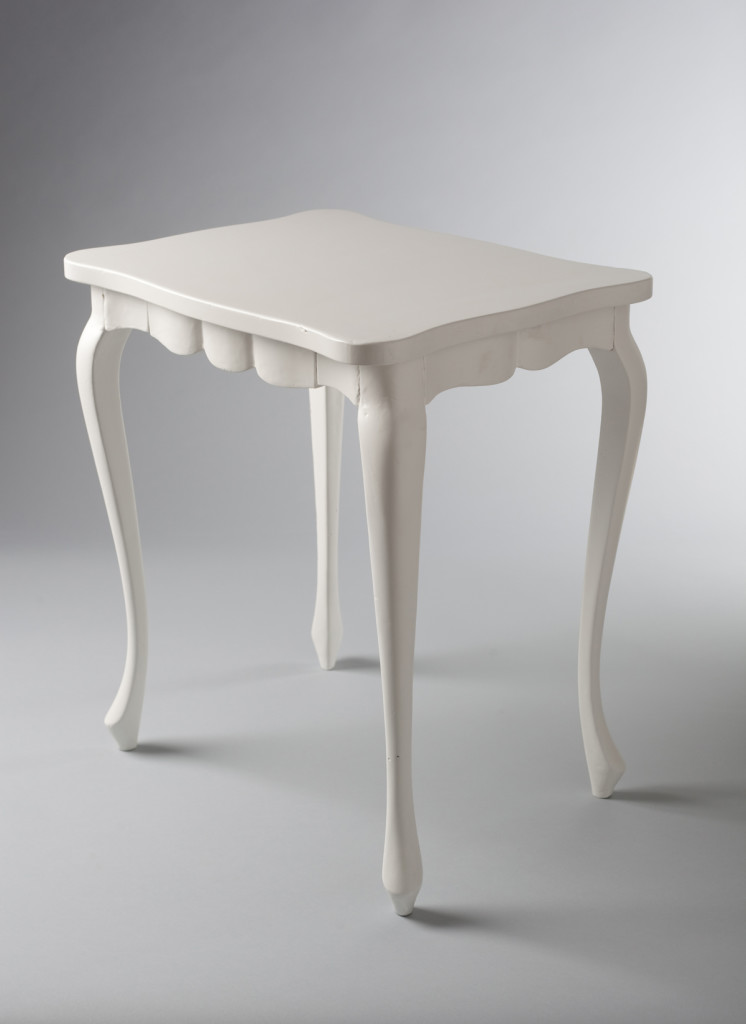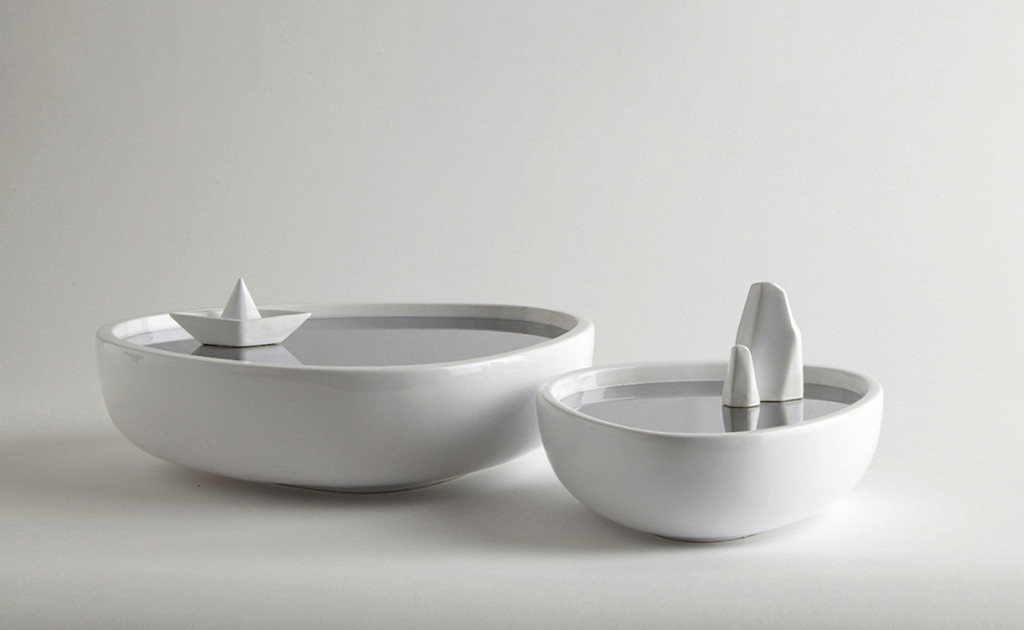Lorenzo De Rosa ed Ernesto Iadevaia lavorano insieme fin dai tempi dell’Università e dieci anni fa hanno dato vita a Sovrappensiero Studio Design, un laboratorio che vuole realizzare progetti profondamente legati alla riflessione creativa ma con consapevolezza.
Sorpresa, semplicità, linee definite prendono forma negli oggetti progettati da questo studio, alcuni dei quali riescono a completarsi in una dimensione onirica, nascondono un racconto che coinvolge chi li osserva a soffermarsi e a portare la mente in altri mondi. Sovrappensiero quindi è un pezzettino del processo creativo, ma soprattutto il modo di relazionarsi con le cose.
Scorrendo il sito di Sovrappensiero, si rimane colpiti per i nomi dei loro progetti, caratterizzati da un legame intrinseco con la funzione e la proposta progettuale, diventando essi stessi parte della storia che vogliono raccontare . Per poter realizzare questa volontà Lorenzo ed Ernesto pongono come linea guida del progetto l’obiettivo principale: così “ Il progetto trova la sua forza nell’idea, e nel giusto equilibrio tra materiali e forme. L’idea però non è tutto, bisogna avere le competenze per concretizzarla a livello produttivo”. Grazie a questo approccio si possono perseguire gli scopi del proprio lavoro, mentre questione ben diversa sono i sogni. “Realizzare un sogno è più difficile perché entra in gioco la fortuna, le circostanze della vita, incontri casuali e fortunati. Non è indispensabile che i sogni si avverino, ma è importante che ci siano e che siano custoditi gelosamente; solo i sogni ci danno il coraggio di rivoluzionare il corso degli eventi”. Il concetto del sogno è ben rappresentata dal Cassetto dei sogni dello Studio, un delicato tavolino con un piccolo cassetto che di fatto ha poco spazio per gli oggetti materiali, essendo composto da una lastra di lavagna, una pagina dove scrivere i propri desideri ma anche per poterli cancellare.
La delicatezza e la semplicità nell’esprimere idee ben definite contraddistingue la linea creativa di Sovrappensiero: né è un esempio Artico, una ciotola dalla forma sincera, chiusa da un coperchio specchiato che conferisce una curiosa profondità immaginifica al contenitore, come se questo si spogliasse della sua funzione e lasciasse galleggiare lontani i pensieri. Artico è “ Un momento di poesia”, è “ Allontanarsi con la mente guardando una barca che si allontana dalla riva”.
Totalmente differente è l’approccio all’idea di Cook, un rubinetto da cucina molto elegante ed intelligente, la cui idea ha avuto la fortuna di incontrare un’azienda produttrice valida che ha saputo dare fiducia al progetto. La proposta nasce dalla volontà di portare i rubinetti a molla per cucine industriali in ambiente domestico attraverso forme materiali e colori più gentili: il risultato è efficace tanto da elevare un oggetto di utilità quotidiana ad oggetto d’arte.
Le proposte dello Studio sono eterogenee: da Diapason, un dispositivo che trasforma la luce del sole in suono ispirandosi ai diapason elettromagnetici, a Rifletti, uno specchio e un imperativo: superare le apparenze. “Rifletti fa parte della collezione di oggetti da noi realizzata Design for the blinds. Quando abbiamo lavorato ai prodotti per non vedenti ci siamo spesso interrogati sui rischi creati dalle apparenze, su come la contemporaneità sia costruita sull’immagine e su come il buio possa essere più vero del velo creato dalla luce. Il nostro specchio è appunto un invito a guardare oltre le apparenze, era esposto alla fine della nostra mostra sugli oggetti per non vedenti, speriamo di essere riusciti a far riflettere”.
Oltre a numerosi oggetti, Sovrappensiero ha partecipato al progetto Atto di fede, commissionato dallo studio Ghigos per la mostra 1:13, cui lo Studio insieme ad altri 12 designer sono stati invitati a disegnare le 13 sedie mai dipinte nell’Ultima Cena, dando una propria interpretazione alle sedute simboliche. Lorenzo ed Ernesto raccontano questa esperienza: “Noi abbiamo avuto l’onore di disegnare la sedia di San Matteo. Siamo partiti da uno dei pochi eventi conosciuti della sua vita: Gesù vide un uomo, chiamato Matteo, seduto al banco delle imposte, e gli disse: «Seguimi» (Mt 9, 9).
Roberto Marone ha scritto un testo molto bello per raccontare il nostro progetto:
I Sovrappensiero sono quel genere di progettisti che usano il disegno delle cose per dire altro da quelle cose. Lo fanno sistematicamente da anni, disegnando oggetti a cui subordinare metafore, icone, messaggi. In pratica, disegnano per parlare. E così viene facile se una mostra di sedie non parla di sedie, ma di Apostoli, e di Ultima Cena. E se San Matteo (uno che prima di diventare Apostolo faceva l’esattore delle tasse) ne diventa l’ispirazione.Pare che Cristo gli abbia detto solo “seguimi” per convertirlo dal mero danaro, allo spirito santo. E quel “seguimi”, nella sedia, diventa il filo che tiene insieme l’unità dell’appoggio, visto che seguire nel caso di Dio non significa andare dietro qualcuno, farne le veci, o rimanere attaccati, ma rimanere fedeli al timone dritto di un qualcosa. Saldi a un principio senza il quale tutto vacilla. E guarda caso quell’ultima cena fu il primo scricchiolio preannunciato: li dove al mancare dei princìpi, persino i prìncipi decadono, e gli dei muoiono. Là dove la linea retta di qualsiasi valore coincide con la linea della gravità. Tradendo quella, crolla tutto. E di questi tempi, non è poco ricordarlo”.
Riflettendo sulle esperienze, sulla ricerca creativa di Sovrappensiero e sul ruolo del design come risposta di un’esigenza ma anche come espressione di un’idea, ci si può chiedere se design stesso possa influire e cambiare il quotidiano. “Da un punto di vista pratico, il Design ha dato vita a molti oggetti funzionali che hanno migliorato la qualità della vita di molti o semplicemente è riuscito a intervenire su alcuni piccoli gesti quotidiani, ma oggi la nascita di una vera invenzione nell’ambito del design è un evento raro. Nella storia dell’uomo, dell’arte, degli oggetti, però, la ricerca della bellezza non ha mai avuto fine: La bellezza salverà il mondo afferma il principe Miškin nell‘Idiota di Dostoevskij. Questa frase si presta a tantissime interpretazioni, basti pensare che nella costruzione russa della frase, oggetto e soggetto sono invertiti: Il mondo salverà la bellezza. Ma qual è la bellezza che salverà il mondo? È una delle domande che non bisogna dimenticare”.
Qual è stata la più grande difficoltà, sfida e scommessa in un Paese come il nostro, in questo determinato periodo storico?
Personalmente? La più grande sfida è restare. Amiamo l’Italia, amiamo Milano come Napoli, siamo riusciti a creare una rete di collaborazioni con molti professionisti della nostra generazione, abbiamo avuto molte soddisfazioni, ma l’Italia è un paese per vecchi.
Come per ogni intervista, chiediamo in conclusione cosa consigliano a chi come loro ha deciso di investire la propria vita nella creatività. Questa la risposta di Sovrappensiero: Essere appassionati. E’ l’unico motore che vi farà andare avanti.
[divider]ENGLISH VERSION[/divider]
Ten years ago, Lorenzo De Rosa and Ernesto Iadevaia, who have been working together since the University, have created the Sovrappensiero Studio Design, a laboratory that aims to create projects deeply related to creative and aware reflection.
The objects designed by this atelier convey surprise, simplicity through defined lines. Some of them reach their completeness in a dreamlike dimension, hiding a story that involves the observer, inviting him to linger and bring the mind into other worlds. Thus, Sovrappensiero is a little piece of the creative process, and especially a way to relate to things.
A glance to the website of Sovrappensiero, and we are struck by the names of their projects characterized by an intrinsic link with the function and the project proposal; they are part of the story they want to tell. To realize this desire that is how Lorenzo and Ernesto pose as a guideline of the project the main goal: “The project finds its strength in the idea and in the right balance between materials and shapes. However, the idea is not all; you need to have the skills to concretize it in production”. With this approach they can pursue the goals of their work, while dreams are different matter. “Realizing a dream is more difficult because the luck comes into play; the circumstances of life, chance and lucky encounters. It is not essential that dreams come true, but it is important that there are dreams and that they are jealously guarded; only dreams give us the courage to revolutionize the course of events”. The concept of the dream is well represented by the Cassetto dei sogni [drawer of the dreams/ a childhood dream N.d.T.], a delicate coffee table with a small drawer that actually has little room for material objects, being composed of a slab of slate; a page where you can write your desires but also you can delete them.
Sovrappensiero’s creative line distinguishes by the delicacy and simplicity in expressing ideas clearly defined. Artico is an example of it; a bowl with a sincere shape, closed by a lid mirror that gives a curious imaginative depth to the container, as if that casts off its function and leaving to float away the thoughts. Artico is “A moment of poetry”; it is like “Getting away with the mind, looking at a boat that moves away from the shore”.
The approach to the idea of Cook is totally different. It is an elegant and smart kitchen faucet, whose idea has had the good fortune to meet a valid manufacturer that gave confidence to the project. The proposal stems from the desire to bring the taps spring for industrial kitchens in the home environment through material forms and more kind colors. The result is effective enough to raise an object from its daily use to be a subject of art.
The proposals of the Studio are heterogeneous: from Diapason, a device that converts sunlight into sound, inspired by the electromagnetic tuning fork; Rifletti, which is a mirror and an imperative [“rifletti” means to reflect, to ponder N.d.T.]: overcome the appearances. “Rifletti is part of the collection Design for the blinds. When we worked on products for sightless people we often questioned about the risks created by appearances, on how the contemporary is built upon images and how the darkness can be more real than the veil created by the light. Our mirror is just an invitation to look beyond appearances. It was exposed at the end of our exhibit on the objects for sightless people; we hope we made people think”.
In addition to numerous articles, Sovrappensiero participated the project Atto di fede commissioned from Ghigos studio for the exhibition 1:13, to which the Studio together with other 12 designers were invited to design the 13 chairs never painted on The Last Supper, giving a own interpretation to the symbolic seats. Lorenzo and Ernesto tell this experience: “We had the honor to draw the chair of St. Matthew. We started with one of the few known events of his life: Jesus saw a man named Matthew sitting at the tax office, and said to him, ‘Follow me’ (Mt 9: 9). Roberto Marone wrote a beautiful text to tell our project: The Sovrappensiero are that kind of designers who use to draw things to say other than those things. They have been doing it routinely for years, drawing objects that make metaphors, icons, and messages. Actually, they draw to talk. And so it is easier if an exhibition of chairs does not speak of chairs, but of the Apostles and of the Last Supper. And St. Matthew (who before becoming Apostle was a tax collector) becomes the inspiration. It is said that Christ has only said ‘follow me’ to convert him from mere money to the Holy Spirit. And that ‘follow me’, in the chair becomes the thread that holds together the unity of the support, as following God does not mean to go behind someone, to be on someone’s place or to remain attached, but stay straight true to the rudder, to be firm to a principle without which everything falters. It just happens that the last supper was the first announced crunch: where missing the principles even the princes decay, and the gods die. Where the straight line of any value coincides with the line of gravity. Betraying that, everything collapses. And these days, is not a little to remember it”.
Reflecting on Sovrappensiero’s experiences and creative research and on the role of design as a response to a need, but also as an expression of an idea, one may wonder if the same design can influence and change daily life. “From a practical point of view, Design has created many functional objects that have improved the quality of life of many or simply succeeded on taking action on some small daily gesture. But today, the birth of a true invention in the field of design is a rare event. However, in human history the pursuit of beauty has never ended. Beauty will save the world says the prince Miskin in the Dostoevsky’s Idiot. This phrase lends itself to many interpretations. Just think that in the construction of the Russian phrase, object and subject are reversed: Beauty will save the world. But what is the beauty that will save the world? It is one of the questions that one should never forgive”.
What were the biggest difficulty, challenge and bet in a country like ours, in this particular historical period? Personally? The biggest challenge is staying. We love Italy; we love Milan and Naples. We have created a network of partnerships with many professionals in our generation. We had a lot of satisfaction, but Italy is a country for old men.
As with any interview, in conclusion we ask what they would recommend to those decided to invest their lives in creativity. This the Sovrappensiero’s response: Be passionate. It is the only engine that will make you go forward.
Traduzione a cura di Daniela De Angelis







